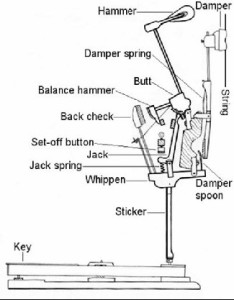Piano Maker’s Corner: Escape Velocity
 This month Daniel Ley answers reader John R.’s questions, “What is the escapement? Is there one on every key? Do I need to have it adjusted every year?” Daniel also gives us some nifty tools to help students (and ourselves) understand more about how an acoustic piano works as well as how to use the escapement to improve our playing. (and no, it has nothing to do with a weekend getaway or rocketships!) Many thanks for reading John!
This month Daniel Ley answers reader John R.’s questions, “What is the escapement? Is there one on every key? Do I need to have it adjusted every year?” Daniel also gives us some nifty tools to help students (and ourselves) understand more about how an acoustic piano works as well as how to use the escapement to improve our playing. (and no, it has nothing to do with a weekend getaway or rocketships!) Many thanks for reading John!
Dear John R.,
An escapement is the mechanism in a piano that allows the hammer of a key to fall away from the string after it is struck, making it much easier to play a soft note repeatedly. Just an instant before the hammer strikes the strings, it “escapes”; it is connection to the key so that it can strike the strings and then fall away from them, allowing them to continue to vibrate.

Although professional piano players have their actions regulated yearly, one does not need to adjust it every year. Piano regulations attend to the mechanical parts, which cause strings to sound when keys are played.
The escapement is adjusted when one is doing other regulation work for all of the keys and action parts. The escapement could be worked on independently, however, the escapement is affected through the adjustment of other parts in the action. There are many dozens of regulations a piano may require. The most important regulations include: the let off (the point when the hammer releases from the jack and flies freely), the drop (how far the hammers fall back after the let-off), and repetition strings (allow a hammer to repeatedly strike a string with minimal lifting of the key).
Daniel Ley


